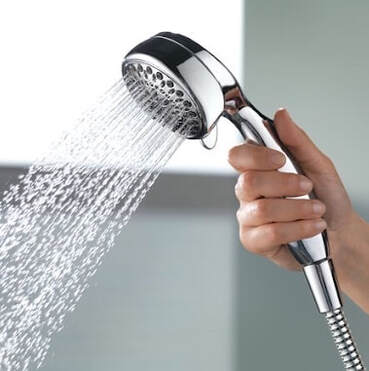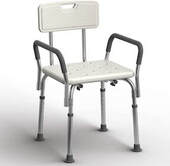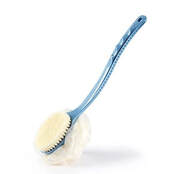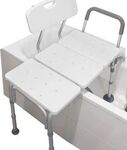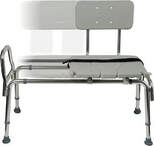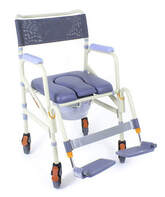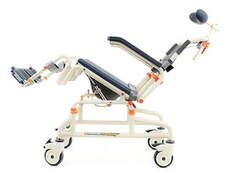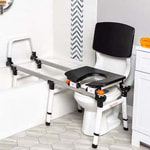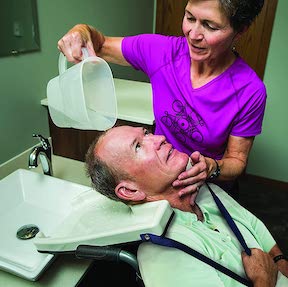|
There are many different devices and strategies that can help you continue to bathe safely with or without assistance. As bathing becomes more challenging, there are a number of strategies and devices that can help you get clean while staying safe, conserving energy, and remaining more independent. The occupational therapist (OT) or physical therapist (PT) at your ALS clinic or home health agency should be able to make recommendations for what will work best for you and your bathroom configuration. |
|
Bath and Shower Safety
|
In the bathroom, safety should be your top priority. If you are having doubts about the safety of your current bathing routine, reach out to your PT or OT for suggestions. If they have not seen your tub/shower setup, you can describe it to them or even send photos or videos.
If no one from your clinic or local ALS organization can do a home visit, ask your PT or OT and neurologist if they can arrange a home safety evaluation by a professional from a home health agency. That person will visit, assess the safety and accessibility of your home (including your bathroom), and make recommendations such as using assistive devices or placing non-slip mats in your tub or shower. This evaluation should be covered by insurance. |
|
Bathing Independently
|
There are a number of devices that can help you continue to bath independently if you are feeling unsteady or getting fatigued while bathing or showering. For example, installing grab bars in and near your tub or shower can help with balance. Permanent grab bars with screws are safer than suction-cup grab bars, which can be unreliable.
|
|
|
Standing while taking a shower uses more energy than you may realize. Sitting down in a shower chair while getting clean can help you prevent falls and save energy for other activities. While sitting, you can use a hand-held showerhead to direct the flow of water.
|
|
|
If you are having trouble scrubbing, reaching down, or cleaning certain parts of your body, you can try devices like long-handled sponges, luffa sponges, or bath mitts. If it is challenging to get soap and shampoo out of their original bottles, transferring them to wall-mounted pumps may make it easier to dispense.
|
|
|
If you are concerned about safely stepping over the tub or lip of the shower, you can use a tub transfer bench or tub slider to slide into the tub and then remain seated on it while bathing.
|
|
Equipment Loan ClosetsYou can potentially save thousands of dollars by borrowing equipment from ALS loan closets. Many local ALS organizations and clinics loan certain types of assistive devices and medical equipment at no cost. Learn more |
|
Bathing with AssistanceIf you no longer feel safe bathing on your own with these devices, or if you find the process too exhausting, it is probably time to ask for assistance from a caregiver, whether a family member, friend, or professional.
|
|
|
If your mobility has become more limited, you may need to be transferred to a rolling shower commode chair and then wheeled into a barrier-free shower. Because space in bathrooms is often tight, it may be easier to transfer into the chair before you enter the bathroom. You can also roll the same chair over the toilet to relieve yourself before or after your shower.
|
|
|
If you feel you need more trunk and neck support than a standard rolling shower chair can provide, a tilt-in-space shower chair with an adjustable headrest will provide greater support.
|
|
Accessible Tub and Shower SolutionsTransfer Benches | Rolling Shower Chairs | Tub and Shower Transfer Systems
Get a 10% discount on SolutionBased products. LEARN MORE |
If there is enough room in your bathroom, you can roll your patient (Hoyer) lift into the shower and take your shower while hanging in a mesh sling.
If you have a feeding tube, you can shower with it uncovered within one to two days after it is placed. Water and soap can gently run over the tube, but do not let the water stream spray directly onto the tube or tube site. When done, gently pat everything dry, especially under the bumper.
If you have a tracheotomy and can tolerate being off the ventilator for the time it takes to bathe, you can use a handheld shower to direct water away from your trach site, which must not get wet. There are commercially available shower shields to help keep the trach site dry. You can then carefully wash your neck once you’re out of the shower. If you need to stay connected to your ventilator, you will need to use an alternate bathing method like getting a sponge bath because you cannot get the ventilator or electrical cords wet.
If you feel that bathing every day is too exhausting or too time-consuming, you could choose to save the time and energy by bathing less often.
Bathing devices are not usually covered by insurance. However, you can ask your ALS clinic or local ALS organization if you can borrow them at no cost from their equipment loan closet. You can also visit our Bathing Devices page to learn more and purchase them directly.
If you have a feeding tube, you can shower with it uncovered within one to two days after it is placed. Water and soap can gently run over the tube, but do not let the water stream spray directly onto the tube or tube site. When done, gently pat everything dry, especially under the bumper.
If you have a tracheotomy and can tolerate being off the ventilator for the time it takes to bathe, you can use a handheld shower to direct water away from your trach site, which must not get wet. There are commercially available shower shields to help keep the trach site dry. You can then carefully wash your neck once you’re out of the shower. If you need to stay connected to your ventilator, you will need to use an alternate bathing method like getting a sponge bath because you cannot get the ventilator or electrical cords wet.
If you feel that bathing every day is too exhausting or too time-consuming, you could choose to save the time and energy by bathing less often.
Bathing devices are not usually covered by insurance. However, you can ask your ALS clinic or local ALS organization if you can borrow them at no cost from their equipment loan closet. You can also visit our Bathing Devices page to learn more and purchase them directly.
Bathing Outside of the Bathroom
|
If getting to the tub or shower is not possible, there are other ways to get bathed and stay clean. Options include using a wheelchair-accessible portable shower stall outside of your bathroom or setting up an inflatable bathtub on your bed. You can get your hair washed either in bed with a shampoo basin or while in your wheelchair by attaching a hair washing tray to the sink.
If you need to get bathed in bed, an occupational therapist or nurse can visit to train your caregiver on proper positioning and techniques for giving a sponge bath or using body wipes. No matter how you do it, it is important to continue to stay clean and practice good hygiene. |
Do you need to renovate your bathroom?
Before rushing to renovate your bathroom (and spending a lot of money), meet with your OT or PT to find out if there are assistive devices that might work well with your current bathroom configuration.
If you have leg weakness and can’t step over the tub, for example, you might be best off keeping your tub and using a tub slider. If, on the other hand, you need a rolling shower commode chair, you may need to replace your bathtub with a barrier-free shower, if possible. And if you have a stall shower with a lip, you may be able to replace it with a flexible barrier that can be rolled over.
If you don’t think your current bathroom configuration meets your current or future needs, you can learn about your options on our Home Accessibility page.
If you have leg weakness and can’t step over the tub, for example, you might be best off keeping your tub and using a tub slider. If, on the other hand, you need a rolling shower commode chair, you may need to replace your bathtub with a barrier-free shower, if possible. And if you have a stall shower with a lip, you may be able to replace it with a flexible barrier that can be rolled over.
If you don’t think your current bathroom configuration meets your current or future needs, you can learn about your options on our Home Accessibility page.

